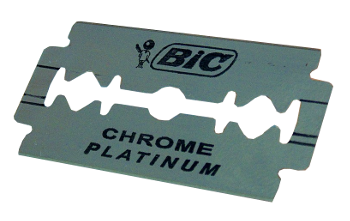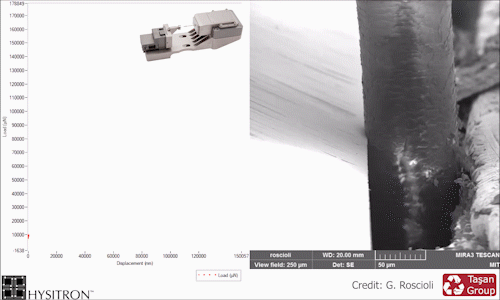Dull Blades
September 21, 2020
Most
boys are excited when they need to first start
shaving their
beard. The excitement soon fades when shaving becomes just another
monotonous morning task, like
tooth brushing. Likewise,
scientists are excited when gathering
data from their first
experiment, only to find that their
profession requires much more. There's the responsibility of ensure that your
statistics are good, that your results are
consistently reproduced, that they're adequately explained by
theory, and the results are summarized in a cogent and
publishable paper.
Science is more than just the
Eureka! moments.
Both
men and
women shave unwanted
hair, and the
global shaving
market is more than $10 billion
annually. There are also many
cultural memes about shaving.
Highways in the
United States were once decorated with novel
advertising signs for the
shaving cream,
Burma-Shave. Unlike the usual
billboard, or
barn, ads, the Burma-Shave ads were a
humorous rhyming "
poems" on a series of small signs, the last of which held the Burma-Shave
logo. The signs were used from 1926 to 1963.

The expansion of the US Interstate Highway System and increased motor vehicle speeds made the Burma-Shave signs less effective, so their use was discontinued in 1963.
The message on this sign relates to pre-pandemic advice from the US Centers for Disease Control and Prevention.[1]
Beard hair can interfere with face piece respirators, such as N95 masks, by preventing an airtight seal, but men can wear cloth masks without trimming their beards.
Widespread mask use slows the spread of COVID-19.
(Modified Wikimedia Commons image, animated using GIMP, the GNU Image Manipulation Program. The base image is a US Library of Congress photograph by Carol M. Highsmith (b. 1946).)
Any article in a science
blog about shaving should mention the
barber paradox of
Bertrand Russell (1872-1970). Russell was a
mathematician who
co-authored with
Alfred North Whitehead (1861-1947) an important
book on
classical logic,
Principia Mathematica. He also won a
Nobel Prize. There is no Nobel Prize in Mathematics, but he was awarded the 1950
Nobel Prize in Literature "in recognition of his varied and significant writings in which he champions
humanitarian ideals and
freedom of thought." The barber paradox is simply stated,
There's a barber who shaves all those, and those only, who do not shave themselves. Does the barber shave himself?
The paradox is that if he does shave himself, he can't be that barber; and, if he doesn't shave himself, he still isn't that barber.
As a testament to how long
product development takes, my
father had an entire drawer full of
electric shavers that he had tried and discarded. Fifty years later, my
son has had more
luck, and he's a dedicated electric shaving fan, although he's had a problem with the purchase of some
counterfeit replacement blades. These are a good target for counterfeiters, since the selling
prices are high, and it's simple to make
facsimiles. I've always used shaving cream for a "wet" shave, using a
double-edged safety razor for most of my life. Now, I've found that my
wife's brand of
disposable razors work just fine for me. The triple-bladed,
laser-processed, men's razors seem like a high-priced advertising
gimmick to me.

Adouble-edged safety razor blade.
I once used such a blade as the fulcrum in a low friction lever in an experiment.
(Modified Wikimedia Commons photograph by András Bögöly.)
Razor blades, like the one shown in the above image, have been used by
telescope makers to test the shape of their
reflector mirror blanks using the
Foucault knife-edge test. This test, devised in 1858 by
French physicist,
Léon Foucault (1819-1868), measures mirror surface deviation from a
parabolic shape using just a
point source of
light (historically, a
light bulb shining through a
pin hole) and the knife edge of a razor blade. It's a stretch to include
Ockham's razor in this article, but I'll do it anyways. The
English Franciscan friar,
William of Ockham (c. 1287-1347), proposed the rule, used by scientists, that the simplest explanation is most likely the right one.
Although wives sometimes complain about their husbands' scratchy beards, hair is still far
softer than the
steel of a razor blade, and new razor blades are capable of cleanly shaving hair. Since razor blades are produced with
alloys and
coatings that prevent their
corrosion, why do razor blades dull after days, rather than years? That was the problem tackled by a team of
materials scientists and
mechanical engineers from
MIT, and their findings are published in a recent issue of
Science.[2-5]
This problem doesn't apply just to razor blades. Even
chef's knives are dulled after cutting such soft
foods as
tomatoes and
potatoes.[4] Most cutting steels have a high
carbon content that leads to a
Martensitic microstructure, and these are often coated with materials intended to enhance hardness and resist wear.[2] The reason why sharp edges become dull after cutting materials significantly softer is poorly understood.[4] Says
Cem Tasan, an
associate professor in the
MIT Department of Materials Science and Engineering and an
author of the study,
"We are metallurgists and want to learn what governs the deformation of metals, so that we can make better metals... In this case, it was intriguing that, if you cut something very soft, like human hair, with something very hard, like steel, the hard material would fail... We found the main ingredients of failure, which enabled us to determine a new processing path to make blades that can last longer."[3]
The MIT research team found that contrary to the expectation that edge rounding and
brittle fracture of a blade's hard coating were responsible for the blade dulling, a detailed microstructural investigation showed a different mechanism.[2,4] The dulling is caused by a combination of out-of-plane
bending,
microstructural heterogeneity, and microscopic chipping along the smooth edge. Fractures at the cutting edge created chipping that dulled a blade faster than other processes.[2]
While the chef who wields a sharp knife would say that "
the proof of the pudding is in the eating," scientific proof comes from experiment.
Gianluca Roscioli, the lead author of the paper, purchased several brands of disposable razors, saw by microscopic analysis with a
scanning electron microscope that their edges were similarly structured, and examined them again over the course of days after shaving his own facial hair.[3,5] He saw that wear was minimal, but chipping was extensive.[3,5] The size of the chips was about a tenth the
diameter of a human hair, and they increased in number the more times the blades were used for shaving.[5] These findings signaled the need for a more controlled experiments.

Splitting hairs. This is an in situ video of a human hair being cut by a razor blade in a scanning electron microscope. The left is a real-time graph of the force encountered by the blade during the cutting. As expected, the force increases until the maximum cutting width (the hair diameter) is reached, and it decreases thereafter. From the force curve, it appears that the hair fractures at the very end. My theory is that the acoustic shock wave from this fracture might explain some of the results. (MIT image by Gianluca Roscioli.)
Controlled experiments were conducted using a small,
micromechanical apparatus placed inside a scanning electron microscope to mimick the shaving process (see image above).[3,5]
commercial razor blades were set at various
angles to cut human hair sampled from
laboratory members.[3] As in the initial shaving experiments, hair caused the blade’s edge to chip, but only under certain cutting conditions.[3] When the hair was cut
perpendicular to the blade, there was no chipping; but, when the hair was free to bend, there was chipping.[3] The razor blades dulled after subsequent cracks accumulated around initial cracks.[3]
computer simulations were done that gave results consistent with the experiments. Blade damage was more likely to occur when the hair was cut at an angle to the blade; when the steel had an heterogeneous composition; and, when the edge of a hair impacted the blade at a weak point in its heterogeneous structure.[3] This type of failure arises from the well-known effect of
stress concentration at the tip a crack.[3] Says study author, Tasan, "Our simulations explain how heterogeneity in a material can increase the stress on that material, so that a crack can grow, even though the stress is imposed by a soft material like hair."[3]
One way to make blades last longer (although this is likely something a
manufacturer might not want to do, since it would limit
sales!) is to create them with a more uniform mirosctructure.[3-5] The MIT group has filed a
provisional patent application on just such a process.[3] Says team member, Roscioli, "The basic idea is to reduce this heterogeneity, while we keep the high hardness... We’ve learned how to make better blades, and now we want to do it."[3]
References:
- Infographic - Facial Hairstyles and Filtering Facepiece Respirators, US Centers for Disease Control and Prevention (PDF File).
- Gianluca Roscioli, Seyedeh Mohadeseh Taheri-Mousavi, and Cemal Cem Tasan, "How hair deforms steel," Science, vol. 369, no. 6504 (August 7, 2020), pp. 689-694, DOI: 10.1126/science.aba9490.
- Jennifer Chu, "Why shaving dulls even the sharpest of razors," MIT Press Release, August 6, 2020.
- How soft hair deforms the sharpest steel blades, American Association for the Advancement of Science Press Release, August 6, 2020.
- Nell Greenfieldboyce, "Cutting-Edge Research Shows How Hair Dulls Razor Blades," NPR-All Things Considered, August 6, 2020.
Linked Keywords: Boy; shaving; beard; monotony; monotonous; morning; toothbrush; tooth brushing; scientist; data; experiment; profession; statistics; reproducibility; consistently reproduced; theory; scientific literature; publishable paper; Science; Eureka! moment; man; men; woman; women; hair; world economy; global; market (economics); year; annual; culture; cultural; meme; highway; United States; advertising; sign; shaving cream; Burma-Shave; billboard; barn; humor; humorous; rhyme; rhyming; poetry; poem; logo; US Interstate Highway System; motor vehicle; message; pre-pandemic; US Centers for Disease Control and Prevention; respirator; face piece respirator; N95 mask; hermetic seal; airtight seal; cloth face mask; hair clipper; trimming; Coronavirus disease 2019; COVID-19; GIMP, the GNU Image Manipulation Program; US Library of Congress photograph; Carol M. Highsmith (b. 1946); blog; barber paradox; Bertrand Russell (1872-1970); mathematician; author; co-author; Alfred North Whitehead (1861-1947); book; classical logic; Principia Mathematica; Nobel Prize; Nobel Prize in Literature; humanitarianism; humanitarian ideals; freedom of thought; product development; father; electric shaver; son; luck; counterfeit; price; facsimile; double-edged razor; safety razor; wife; disposable razor; laser peening; gimmick; fulcrum; low friction; lever; experiment; Wikimedia Commons; András Bögöly; optical telescope; Newtonian telescope; reflector; mirror; Foucault knife-edge test; France; French; physicist; Léon Foucault (1819-1868); paraboloid; parabolic shape; point source; light; incandescent light bulb; pinhole (optics); Ockham's razor; English people; Franciscan friar; William of Ockham (c. 1287-1347); hardness; soft; steel; alloy; coating; corrosion; materials science; materials scientist; mechanical engineering; mechanical engineer; Massachusetts Institute of Technology; MIT; Science (journal); chef's knife; food; tomato; potato; carbon; Martensite; Martensitic; microstructure; Cem Tasan; associate professor; MIT Department of Materials Science and Engineering; author; metallurgist; deformation (engineering); metal; failure causes; brittle fracture; bending; microstructure; microstructural; heterogeneity; the proof of the pudding is in the eating; Gianluca Roscioli; scanning electron microscope; hair's breadth; diameter of a human hair; in situ; video clip; razor blade; Cartesian coordinate system; force; fracture; theory; acoustic shock wave; microtechnology; micromechanical; scientific instrument; apparatus; commerce; commercial; angle; laboratory; perpendicular; computer simulation; stress concentration; manufacturer; sale; provisional patent application.